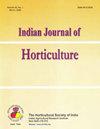Genetic diversity for curd yield and its attributes in late cauliflower
Q4 Agricultural and Biological Sciences
引用次数: 1
Abstract
Genetic diversity was studied in 26 genotypes of late group of cauliflower during winter 2018-19 and 2019- 20. Based on mean performance, DPCaCMS-1 produced significantly high marketable curd weight, 27.38% better than the best check. D2 analysis clustered the genotypes in seven clusters, with the maximum in Cluster I. Genotypes from clusters V and VI with higher inter-cluster genetic divergence would be a valuable source of genes for improvement. Cluster IV represented maximum mean values for marketable curd weight. The maximum contribution towards genetic diversity was made by days to curd initiation followed by leaves/plant and curd diameter. Principal component analysis indicated the five most informative principal components with more than one eigen value, accounting for 83.59% of the total variance for all traits. The genotypes, namely, DPCafW3, DPCaf US, DPCaCMS-1, DPCaCMS-2, DPCaf-1, DPCaCMS-3, DPCaf30, DPCaf13, and DPCafS5-1 seem to be the promising potential genotypes that can be involved in hybridization programmes to identify transgressive segregants with desirable attributes.晚花凝乳产量及其性状的遗传多样性
研究了2018-19和2019- 20冬季花椰菜晚组26个基因型的遗传多样性。从平均性能来看,DPCaCMS-1的可销售凝乳重量显著高于最佳检查,提高了27.38%。D2分析将基因型聚在7个聚类中,以聚类i最多,聚类间遗传差异较大的聚类V和聚类VI的基因型可能是改良基因的重要来源。聚类IV代表可销售凝乳重量的最大平均值。对遗传多样性贡献最大的是凝乳起始天数,其次是叶片/株和凝乳直径。主成分分析显示,信息量最大的5个主成分特征值大于1个,占所有性状总方差的83.59%。这些基因型,即DPCafW3、DPCaf US、DPCaCMS-1、DPCaCMS-2、dpcaf1、DPCaCMS-3、DPCaf30、DPCaf13和DPCafS5-1,似乎是有前途的潜在基因型,可以参与杂交计划,以识别具有理想属性的入侵分离。
本文章由计算机程序翻译,如有差异,请以英文原文为准。
求助全文
约1分钟内获得全文
求助全文
来源期刊

Indian Journal of Horticulture
农林科学-园艺
CiteScore
0.50
自引率
0.00%
发文量
22
审稿时长
4-8 weeks
期刊介绍:
Information not localized
 求助内容:
求助内容: 应助结果提醒方式:
应助结果提醒方式:


